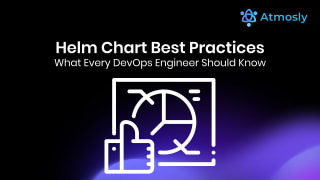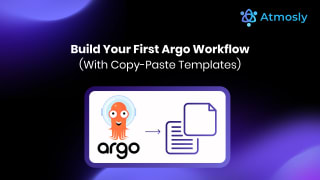Introduction
The software development landscape is undergoing a significant transformation, driven by technology's rapid evolution and the increasing demand for scalable and efficient software solutions. In this era of cloud computing, where innovation and agility are paramount, a new discipline has emerged to revolutionize software development: Platform Engineering. This article explores platform engineering, from its definition and scope to its impact on software development productivity and the steps to build a platform engineering team. We'll also take a closer look at how Atmosly, a forward-thinking technology company, is leveraging platform engineering to deliver advanced, efficient solutions to its clients.
Platform Engineering Explained
Defining of Platform Engineering
Platform engineering is the practice of designing, developing, and maintaining internal developer platforms (IDPs) that empower software development teams to build, deploy, and manage applications efficiently. These platforms act as a bridge between developers and the underlying infrastructure, providing a standardised and automated environment for coding, testing, and deploying software.
The primary goal of platform engineering is to eliminate the operational overhead traditionally associated with software development, allowing developers to focus on writing code and delivering value to end-users. This is achieved through the integration of various tools and technologies, including continuous integration (CI) tools, container orchestration systems like Kubernetes, Infrastructure as Code (IaC) tools, monitoring solutions, and more.
The Role of Internal Developer Platforms (IDPs)
Internal developer platforms are at the core of platform engineering. They are tailored to the specific needs of development teams within an organisation. IDPs offer a centralised, self-service interface that abstracts the complexities of infrastructure provisioning and management. They provide predefined templates, configurations, and best practices, enabling developers to quickly and consistently deploy their applications.
Key features of IDPs include:
- Self-Service Provisioning: Developers can provision infrastructure resources on-demand, reducing dependency on operations teams.
- Standardized Environments: IDPs ensure that development, testing, and production environments are consistent, reducing the it works on my machine problem.
- Automated CI/CD Pipelines: IDPs integrate with CI/CD pipelines, automating the build, test, and deployment processes.
- Scalability and Flexibility: IDPs enable developers to scale their applications effortlessly, responding to changing workloads and demands.
Key Tools in Platform Engineering
Platform engineers leverage a variety of tools to build and manage internal developer platforms effectively. These tools are essential for automating infrastructure provisioning, continuous integration, container orchestration, and more. Some of the key tools in platform engineering include:
- Continuous Integration (CI) Tools: CI tools like Jenkins, Travis CI, and CircleCI automate the process of integrating code changes into a shared repository, ensuring that new code doesn't break existing functionality.
- Kubernetes: Kubernetes has become the de facto standard for container orchestration. It simplifies the deployment and scaling of containerized applications.
- Infrastructure as Code (IaC) Tools: Tools like Terraform and AWS CloudFormation allow developers to define infrastructure in code, making it more manageable, versionable, and reproducible.
- Monitoring and Observability Tools: Tools like Prometheus and Grafana enable real-time monitoring and analytics, ensuring the health and performance of applications and infrastructure.
- Service Mesh: Service mesh technologies like Istio and Linkerd provide advanced networking capabilities, improving the resilience and security of microservices-based applications.
Platform Engineering vs. DevOps
To understand the significance of platform engineering, it's important to distinguish it from DevOps, a term widely used in the software industry for over a decade.
Distinct Roles
DevOps is a cultural and organisational approach that emphasises collaboration and communication between development and operations teams. It aims to break down silos, streamline processes, and foster a culture of automation and continuous improvement. In contrast, platform engineering is primarily a technical discipline that focuses on providing developers with the tools and platforms they need to work efficiently.
While DevOps is a broad philosophy that encompasses both cultural and technical aspects, platform engineering is primarily a technical discipline. It involves designing and implementing the actual platforms that developers use to build, test, and deploy their code.
Emergence from DevOps
Platform engineering can be seen as an evolution of DevOps. As organisations embraced DevOps practices, they recognized the need for specialised platforms to support these practices effectively. This realisation led to the emergence of platform engineering as a distinct discipline within the broader DevOps landscape.
Platform engineering takes the principles of DevOps and applies them to the development of internal developer platforms. It addresses the specific challenges developers face in managing infrastructure, automating workflows, and ensuring the reliability of their applications.
Comparative AnalysisLet's delve deeper into the comparative analysis of DevOps and platform engineering:

While DevOps and platform engineering share common goals of improving software delivery and quality, platform engineering narrows its focus on providing technical solutions to address the challenges of modern software development.
Impact on Software Development and Productivity
Platform engineering has a profound impact on software development and productivity. Let's explore the ways in which it enhances developer productivity and influences various aspects of software development in the cloud era.
Enhancing Developer Productivity
One of the primary benefits of platform engineering is its ability to boost developer productivity. By abstracting away the complexities of infrastructure management, developers can focus solely on writing code and building features. Here's how platform engineering accomplishes this:
- Reduced Cognitive Load: Developers no longer need to worry about provisioning servers, configuring networks, or managing container orchestration. IDPs handle these tasks, reducing the cognitive load on developers.
- Faster Development Cycles: IDPs integrate with CI/CD pipelines, automating the build and deployment processes. This results in shorter development cycles and faster time-to-market for new features and updates.
- Consistency Across Environments: IDPs ensure that development, testing, and production environments are consistent, eliminating the it works on my machine problem. Developers can confidently test and deploy code in various environments without unexpected issues.
- Self-Service Infrastructure: Developers can provision the resources they need on-demand, reducing dependencies on operations teams. This self-service model empowers developers to act independently, speeding up development processes.
Impact on Software Development
Platform engineering has a far-reaching impact on software development practices:
- Agile Development: With faster development cycles and automated workflows, software development becomes more agile. Teams can respond quickly to changing requirements and market demands.
- Microservices and Containers: Platform engineering encourages the adoption of microservices architecture and containerization. This modular approach enhances scalability, fault tolerance, and ease of deployment.
- Infrastructure as Code (IaC): Platform engineering promotes the use of IaC, making infrastructure more predictable, versionable, and easily reproducible. This improves infrastructure management and reduces the risk of configuration drift.
- Shift-Left Security: By incorporating security measures into the platform and CI/CD pipelines, platform engineering enables a shift-left approach to security. Vulnerabilities can be identified and addressed early in the development process.
Integration of AI
As platform engineering advances, the integration of artificial intelligence (AI) plays a pivotal role in further enhancing software development and operational efficiency. AI is leveraged for various purposes within platform engineering:
- Performance Monitoring: AI-powered monitoring tools can analyse vast amounts of data in real-time, identifying performance bottlenecks and anomalies. This proactive approach to monitoring ensures optimal application performance.
- Predictive Analytics: AI can predict potential issues before they occur, enabling proactive maintenance and reducing downtime. Predictive analytics can also optimise resource allocation in cloud environments.
- Auto-Scaling: Machine learning algorithms can analyse application workloads and automatically adjust resource allocation to optimise cost and performance. This is particularly valuable in cloud-native environments.
- Security: AI-driven security solutions can detect and respond to security threats in real-time, enhancing the security posture of applications and infrastructure.
The integration of AI in platform engineering represents the next frontier in software development, where data-driven insights and automation further elevate the efficiency and reliability of software systems.
Building a Platform Engineering Team
Establishing a platform engineering team requires careful planning and execution. Here are the essential steps to initiate and build a successful platform engineering team:
1. Define the Objectives
Clearly define the objectives and goals of your platform engineering team. What specific problems do you want to address? What outcomes do you expect to achieve? Having a well-defined mission is crucial for the success of your team.
2. Identify Roles and Responsibilities
Determine the roles and responsibilities within the team. Key roles typically include:
- Platform Owners: These individuals are responsible for defining the overall strategy and vision for the platform engineering team.
- Platform Engineers: Platform engineers are responsible for designing, developing, and maintaining the internal developer platforms.
- DevOps Engineers: DevOps engineers can complement the platform engineering team by focusing on broader infrastructure automation and CI/CD pipeline development.
1. Executive Buy-In
Securing executive buy-in and support is essential for the success of your platform engineering initiative. Convey the value proposition and long-term benefits of platform engineering to stakeholders and decision-makers.
- Assemble the Team
Recruit talented individuals who have expertise in cloud technologies, automation, containerization, and CI/CD practices. Building a team with a diverse skill set ensures a well-rounded approach to platform engineering.
- Create a Culture of Collaboration
Promote a culture of collaboration and knowledge sharing within the team. Encourage cross-functional collaboration with development, operations, and other teams.
- Select the Right Technologies
Choose the appropriate technologies and tools for building and managing your internal developer platforms. Consider factors such as scalability, compatibility with existing systems, and long-term support.
- Continuous Learning
Invest in the continuous learning and development of your platform engineering team. Technology is constantly evolving, and staying up-to-date is crucial for success.
- Measure and Iterate
Establish key performance indicators (KPIs) to measure the effectiveness of your platform engineering efforts. Regularly review these metrics and iterate on your processes and platforms to drive continuous improvement.
Platform Engineering at Atmosly
Redefining Platform Engineering with Atmosly: A SaaS Evolution
At Atmosly, our journey in platform engineering began as SquareOps, a DevOps service provider keenly understanding the industry's need for a consistent, self-service platform. We recognized the common challenges faced by cloud-native companies, primarily centred around application deployment and cloud infrastructure provisioning. This insight led to the development of Atmosly, not just for internal use but as a transformative SaaS solution for the broader market.
Atmosly's Approach: Empowering Through Self-Service
Our ethos at Atmosly is to empower organisations with the ability to effortlessly manage application deployment and infrastructure. We've created a platform that simplifies these critical processes, offering a seamless, self-service experience. This approach has enabled us to address the universal challenges across organisations, ensuring they have the tools to adapt and thrive in the cloud-native landscape.
Client-Centric Benefits of Atmosly
Atmosly’s platform engineering solution offers significant advantages to our clients:
- Multi Account , Multi Cloud Setup : Atmosly takes cares of provisioning of all cloud resources through IAC to provide consistent Infrastructure every time
- Application Deployment: Atmolsy takes care of the entire deployment process once application configuration is provided. This helps in 20X speed to build new environments or configure any changes
- Quality and Consistency: Our platform ensures a high level of product quality and consistency by centralising the security and configuration, enhancing developer’s productivity and business goals
- Cost-Effective Management: Atmosly optimises resource utilisation, translating into substantial cost savings for our clients.
Conclusion
In the cloud era of software development, platform engineering has emerged as a transformative discipline that empowers organizations to build, deploy, and manage software more efficiently than ever before. By providing internal developer platforms, automating processes, and leveraging advanced technologies like AI, platform engineering enhances developer productivity and drives innovation.
As organizations continue to embrace platform engineering, they will be better equipped to navigate the complexities of modern software development, respond to market changes rapidly, and deliver high-quality solutions to their clients. Atmosly's commitment to platform engineering serves as a shining example of how this discipline can revolutionize software development, ultimately paving the way for a more agile, efficient, and customer-centric future.






